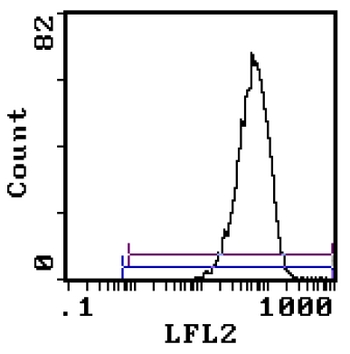Itga4 Rat Monoclonal Antibody [Clone ID: R1-2]
Other products for "Itga4"
Specifications
| Product Data | |
| Clone Name | R1-2 |
| Applications | FC |
| Recommended Dilution | Flow Cytometry (See Protocols). This clone is also reportded to work in Immunoprecipitation and Immunohistochemistry. (1,2,3) |
| Reactivities | Mouse |
| Host | Rat |
| Isotype | IgG2b |
| Clonality | Monoclonal |
| Immunogen | Peyers Patch HEV binding lymphoma line (TK1). Donor: Fisher Spleen. Fusion Partner: P3x63Ag8.653. |
| Specificity | This CD49d Monoclonal Antibody reacts with Alpha-4 integrin (CD49d/ITGA4). |
| Formulation | PBS containing 0.02% Sodium Azide as preservative and EIA grade BSA as a stabilizing protein to bring total protein concentration to 4-5 mg/ml Label: PE State: Liquid purified Ig fraction |
| Concentration | lot specific |
| Purification | Protein G Chromatography |
| Conjugation | PE |
| Storage | Store the antibody undiluted at 2-8°C. DO NOT FREEZE! This product is photosensitive and should be protected from light. |
| Stability | Shelf life: one year from despatch. |
| Gene Name | integrin alpha 4 |
| Database Link | |
| Background | CD49d helps to mediate cell-cell and cell-matrix interactions. Alpha-4 integrin combines with b1 and b7 integrin to form VLA-4 and LPAM-1 (Peyers patch homing receptor) respectively. VLA-4 is expressed on most peripheral lymphocytes, thymocytes and monocytes. LPAM-1 is found on peripheral lymphocytes, but few thymocytes. Fibronectin and VCAM-1 act as ligands for both VLA-4 and LPAM-1. LPAM-1 also binds the mucosal vascular addressin MAdCAM-1. (1) |
| Synonyms | Integrin alpha-4, Integrin alpha-IV, VLA-4, VLA4 |
| Note | Protocol: Flow Cytometry Analysis: Method: 1. Prepare a cell suspension in media A. For cell preparations, deplete the red blood cell population with Lympholyte®-M cell separation medium. 2. Wash 2 times. 3. Resuspend the cells to a concentration of 2x10e7 cells/ml in media A. Add 50 µl of this suspension to each tube (each tube will then contain 1x106 cells, representing 1 test). 4. To each tube, add ~1.0 µg* of CL030R or CL030RX. 5. Vortex the tubes to ensure thorough mixing of antibody and cells. 6. Incubate the tubes for 30 minutes at 4°C. (It is recommended that the tubes are protected from light since most fluorochromes are light sensitive). 7. Wash 2 times at 4°C. 8. Resuspend the cell pellet in 50 µl ice cold media B. 9. Transfer to suitable tubes for flow cytometric analysis containing 15 µl of propidium iodide at 0.5 mg/ml in PBS. This stains dead cells by intercalating in DNA. Media: A. Phosphate buffered saline (pH 7.2) + 5% normal serum of host species + sodium azide (100 μl of 2M sodium azide in 100 mls). B. Phosphate buffered saline (pH 7.2) + 0.5% Bovine serum albumin + sodium azide (100 μl of 2M sodium azide in 100 mls). Results: Tissue Distribution by Flow Cytometry Analysis: Mouse Strain: BALB/c Cell Concentration : 1x10e6 cells per test Antibody Concentration Used: 1.0 µg/106 cells Isotypic Control: PE Rat IgG2b Cell Source Percentage of cells stained above control: TK1 cell line: 100% Thymus: 93.5% Spleen: 92.7% Bone Marrow 88.0% Strain Distibution: Cell Concentration: 1x10e6 cells per test Antibody Concentration Used: 1.0 µg/10e6 cells Strains Tested: BALB/c, C57BL/6, C3H/He, CBA/J, AKR Positive: BALB/c, C57BL/6, C3H/He, CBA/J, AKR Negative: None. |
| Reference Data | |
Documents
| Product Manuals |
| FAQs |
| SDS |
{0} Product Review(s)
0 Product Review(s)
Submit review
Be the first one to submit a review
Product Citations
*Delivery time may vary from web posted schedule. Occasional delays may occur due to unforeseen
complexities in the preparation of your product. International customers may expect an additional 1-2 weeks
in shipping.






























































































































































































































































 Germany
Germany
 Japan
Japan
 United Kingdom
United Kingdom
 China
China



